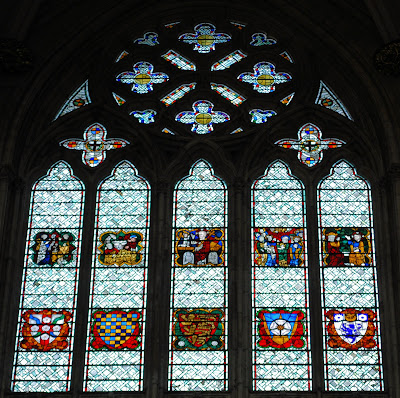Moving along, we come to our next window in York Minster. I've not paired this one with the next one in line, because some of the arms are newer as opposed to the historical ones with arms we have seen elsewhere in the Minster, and so I have included more explanatory information.
Though this window follows the same overall pattern as the others in this series as the others, three of the five coats of arms are much more recent (that is, late 20th century); the only historical arms, which we have seen a number of times elsewhere in the cathedral (and which we will no doubt be seeing again in future posts from the Minster), are those of England and Warrene.
From left to right, these are the arms of:
The North Yorkshire County Council, Argent a bendlet wavy azure and a bendlet sinister wavy vert surmounted by a cross gules charged with five roses argent seeded or. The arms were officially granted on 29th April 1980. The red cross of St. George (which appeared in the arms of the former North Riding County Council and is also in the York City arms) has been charged with five white roses. The blue and green wavy bendlets represent the streams and the hills of the Yorkshire Dales and the Wolds;
Warenne, Earl of Sussex, Checky or and azure;
England, Gules three lions passant guardant in pale or;
The West Yorkshire County Council, Or two piles azure overall a rose argent seeded or. The two main charges (the piles) form the letter W, and the rose is the symbol for Yorkshire, thus creating a kind of canting type of arms. The shield, granted in 1975, is divided into five parts, three gold and two blue, which stand for the five districts of West Yorkshire, as do the five petals of the rose (albeit that as a general convention, roses normally have five petals); and
The Cleveland County Council, Argent a lion rampant azure crowned or and gorged with a collar compony ermine and or breathing flames proper on a chief wavy azure on a pale sable fimbriated between on the dexter a cogwheel and on the sinister a voided hexagon argent an ancient ship sails furled pennons flying or.
Now, to my mind, and this is certainly a personal opinion only and not to be taken as any kind of stricture or scripture, the length and complexity of the blazon is indicative of the complexity of the shield, and is not - again, in my own opinion - a mark of good heraldry. Good heraldry ought to be relatively simple, quickly identifiable, and clear. There are just too many "fiddly bits" in this armory to be that, and the blazon pretty clearly demonstrates that. On the other hand, it's a county council, and the design had to satisfy the many, varied, and often heraldically-uneducated opinions and desires of its members. (I recall the old saw that "A camel is a horse designed by committee.") And I have to admit that it's not as bad as it might be. But then again, "it could be worse" is a pretty low bar to set as a standard for evaluating heraldry.
And that said, the arms of the West Yorkshire County Council and of the North Yorkshire County Council are also defunct, as each entity was replaced, in 1986 and 2023, respectively, by other instituions which do not use arms, but only modern logos based on the white rose of York.
Sic transit gloria.












No comments:
Post a Comment